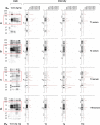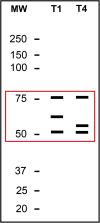Differentiation of Trichinella species (Trichinella spiralis/Trichinella britovi versus Trichinella pseudospiralis) using western blot
- PMID: 30541617
- PMCID: PMC6291991
- DOI: 10.1186/s13071-018-3244-3
Differentiation of Trichinella species (Trichinella spiralis/Trichinella britovi versus Trichinella pseudospiralis) using western blot
Abstract
Background: Trichinellosis is a meat-borne zoonotic disease caused by parasites of the genus Trichinella. To date, 12 taxa have been described. The identification of Trichinella species is crucial in order to identify the possible source of infection, the geographical origin of the parasite and to assess risk of infection for domestic pigs and humans. Specific identification of the etiological agent is not always feasible using direct methods since the source of infection can be untraceable. The aim of this study was to develop a diagnostic tool to infer the causative Trichinella species using western blot patterns of sera derived from infected animal and human hosts.
Methods: Sera from mice experimentally infected with Trichinella spiralis, Trichinella britovi, Trichinella pseudospiralis and Trichinella papuae were tested by western blot using homologous and heterologous crude worm extracts (CWE) and a highly sensitive detection system based on chemiluminescence. In addition, sera from pigs experimentally infected with T. spiralis, T. britovi and T. pseudospiralis and from patients with confirmed T. spiralis, T. britovi and T. pseudospiralis infections, were also included.
Results: Sera from mice infected with one Trichinella species reacted with CWE proteins from all four investigated species. Likewise, sera derived from pigs and humans infected with one Trichinella species reacted with CWE proteins from all the three investigated species. Using T. spiralis CWE, sera from T. pseudospiralis-infected hosts yielded a characteristic pattern of reactivity using Wb, which differed to that produced by T. spiralis/T. britovi- or T. papuae-infected host sera.
Conclusions: The present study suggests that western blot using T. spiralis CWE may be a useful tool to distinguish Trichinella infections caused by T. pseudospiralis from those caused by T. spiralis or T. britovi. This method may support epidemiological investigations, particularly when the source of infection is not traceable.
Keywords: Crude worm extract; Diagnosis; Epidemiology; Serology; Trichinella; Western blot.
Conflict of interest statement
Ethics approval and consent to participate
Mice and pigs were housed and treated according to the European directive on laboratory animal welfare (European Commission, 2010 and L.D. 26/2014) and the protocols were approved by the Italian Ministry of Health (DL 116/92 and 11/2016 UT, respectively). All of the human participants provided informed consent to have blood samples drawn.
Consent for publication
Not applicable.
Competing interests
The authors declare that they have no competing interests.
Publisher’s Note
Springer Nature remains neutral with regard to jurisdictional claims in published maps and institutional affiliations.
Figures






References
-
- Dupouy-Camet J, Bruschi F. Management and diagnosis of human trichinellosis. In: Dupouy-Camet J, Murrell KD, editors. FAO/WHO/OIE guidelines for the surveillance, management, prevention and control of trichinellosis. 1. Paris: FAO/WHO/OIE; 2007. pp. 37–68.
Publication types
MeSH terms
Substances
Grants and funding
LinkOut - more resources
Full Text Sources

